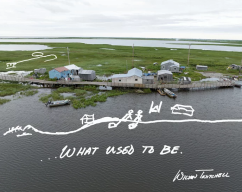
Twitchell and his wife, Bertha, are raising seven children in their small home in Kasigluk, a village of about 450 people in Southwest Alaska. These days, their house is sinking. One side is so sunken into the wet, marshy ground that when neighbors walk past the kitchen window, all the Twitchells can see are their knees. The Twitchells aren’t sure how much longer this house will be standing.
Like the Twitchells, families in Alaska Native communities across the state are in a race against time. Human-caused climate change is warming the region and melting the frozen mixture of ice, rock and dirt that forms the base for much of the landscape. That’s weakening everything from homes and schools to water and sanitation (公共卫生) systems. Alaska Native communities have been raising the alarm for years, warning that melting permafrost (永久冻土) and erosion (侵蚀) threaten their ability to stay on the land where their families have lived for generations. Now, officials say, the issue has reached a breaking point.
The simplest solution for the Twitchell family would be to move across the river. Nearly everyone in Kasigluk agrees that the best solution is for the families to move across the river to Akula. The question is how to pay for it — especially in a village, and region, where much of the community lives below the poverty line.
For most people, moving across the river would mean building a new house. Like much of rural Alaska, Kasigluk has a severe housing shortage, and most of the threatened homes have deteriorated too much to relocate. But building in rural Alaska is extremely expensive. There are no roads connecting Kasigluk to the nearest town. The community relies on planes and snowmobiles to travel in winter, or boats in summer. Most supplies and construction crews have to come by plane or boat.
The traditional council has spent years working on a way to get residents to the safer side of the river. But they’re constantly struggling with the complicated process, running up against a lack of funds and dealing with red tape (繁文缛节). “It’s pretty stressful,” official Nickefer Kassel said. “At times it feels like everything is in a stall. It’s frustrating.”
原创编写 版权所有 侵权必究! 每日更新 个性化阅读 英语飙升!
1.What happened to the Twitchells?
A They live too far away.
B They have too many kids.
C They are losing their house.
D The neighbors are avoiding them.
解析:选C。C细节理解题。根据第一段中的“their house is sinking”“The Twitchells aren’t sure how much longer this house will be standing.”可知,特维切尔家的房子正在下沉,他们不知道这座房子还能支撑多久。即他们正在失去这座房子。故选C。
2.What’s the primary cause of a sinking house?
A Weak foundation.
B Lazy government.
C Angry people.
D Warmer climate.
解析:选D。D细节理解题。根据第二段中的“Human-caused climate change is warming the region and melting the frozen mixture of ice, rock and dirt that forms the base for much of the landscape.”可知,主要原因是人类造成的气候变化。故选D。
3.What made it difficult for people to move away?
①Lack of money.
②Complex process.
③Outdated technology.
④Limited transportation.
A ①②③
B ①③④
C ①②④
D ②③④
解析:选C。C细节理解题。根据最后三段中的“lives below the poverty line”“There are no roads connecting Kasigluk to the nearest town.”“the complicated process”等可知,这些居民搬家所遇到的问题是贫穷、交通不便、流程复杂。故选C。
4.What does the underlined word “deteriorated” probably mean?
A Improved.
B Continued.
C Changed.
D Worsened.
解析:选D。D词义猜测题。根据划线单词前后文的“most of the threatened homes”“too much to relocate”可推知,此处指的是大多数受到威胁的房屋已经严重变坏,无法重新安置。由此推断,划线单词“deteriorated”与worsened同义。故选D。
